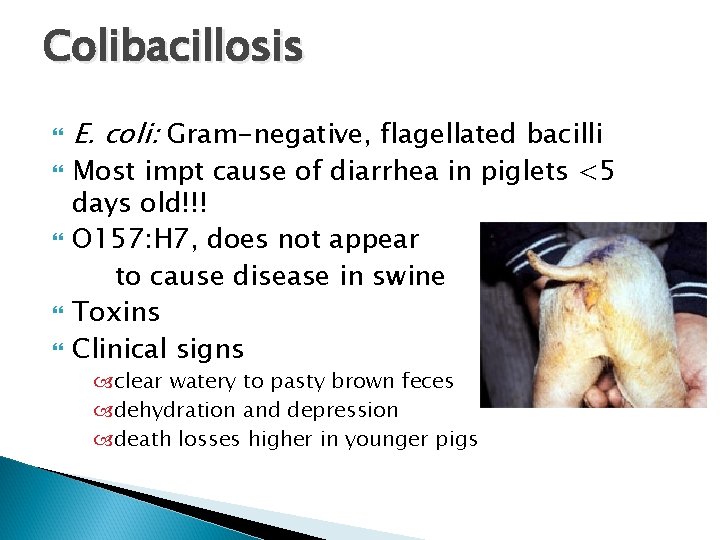Bacterial and parasitic infections are common in piggery.
Diarrhea is usually a common symptom of most of pig diseases, however diarrhea caused by the bacterium Escherichia coli is the most common cause of death in piglets.
It usually causes illness in neonatal and pigs that are just weaned, and later result in death.
What is Escherichia coli?
Enteric Colibacillosis is normal inhabitants of the intestinal tract, particularly the large intestine.
E. coli causes a systemic infection (Colibacillosis) which can manifest in different ways.
Causes of Colibacillosis in Pigs
There are different ways pigs get E.coli, but the main thing is the trigger.
- Stress
E. coli are usually found in the pig intestines but various stress conditions cause these bacteria to multiply rapidly in the small intestine and cause harm to the host (pig)
The bacteria produce toxins that stimulate a massive fluid loss into the small intestine, leading to scours and dehydration.
Enteric Colibacillosis scours is primarily a problem in piglets up to 10 days of age.
The sows remain healthy, the piglets will continue to suckle, they develop severe watery diarrhea and mortality can be heavy.
E. coli in Pigs Symtoms
The symptoms of Enteric Colibacillosis are the following
- Fever
- Stomach cramps
- Watery yellow or brown diarrhea
- Mucus discharge
- Blood fluid discharge
The infection usually spread slowly among newly-born piglets.
Mucus and blood are symptoms of the chronic stage of E. coli.
Treatment of E. Coli in Pigs
The main preventative measure that can be used against E. coli scours is good management.
Since prevention is always better than cure, you should not give room for stressful conditions in the piglets which will trigger scouring.
Antibiotics that are given to the pigs orally can be effective if given immediately symptoms are noticed.
Vaccines are also available in animal’s health’s stores which when given to sows and gilts, help ensure that newborn piglets receive additional antibodies via the colostrum.
What is Edema in Pigs?
Gut Edema or Bowel Edema is another condition caused by E. coli.
It affects pigs after weaning, normally between eight and 25kg live-weight.
Intestinal Edema is most prevalent in the fastest growing pigs and the typical symptom is edema in the region of the stomach and intestines.
Causes and Symptoms of Edema
Pigs begin to stagger and will often die after exhibiting convulsions.
The proportion of animals that are affected will vary considerably.
It is generally believed that stress is the major cause of gut edema, particularly overeating of high protein diets.
Treatment of Edema
The disease can be contained by reducing feed intake, increasing the fiber level, and lowering the protein content of the ration.
The clinical signs are a raised body temperature and an increased respiration rate accompanied by bouts of coughing.
Enzootic pneumonia is a complex condition in which various environmental conditions and stress are involved.
The mycoplasmas are resistant to antibiotics and the best policy is to try to keep a herd free from the disease.
Antibiotic treatment is useful to prevent the occurrence of secondary infections, which can occur.








